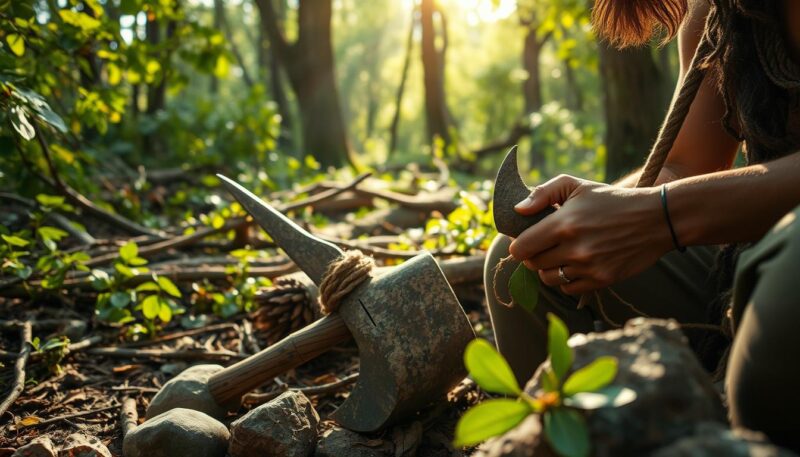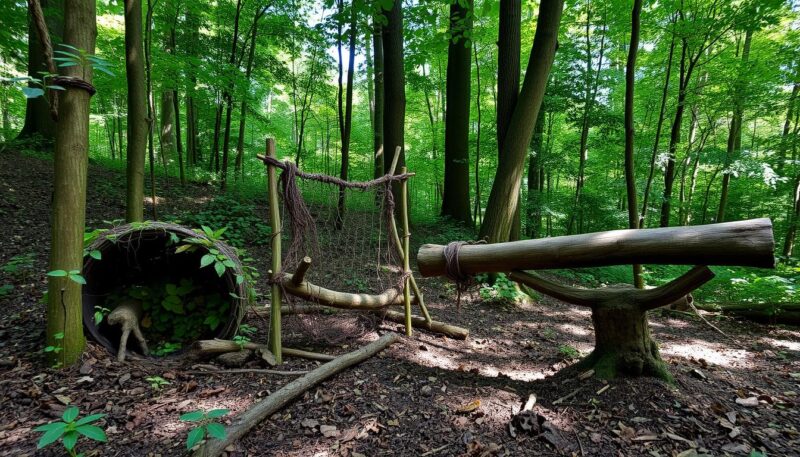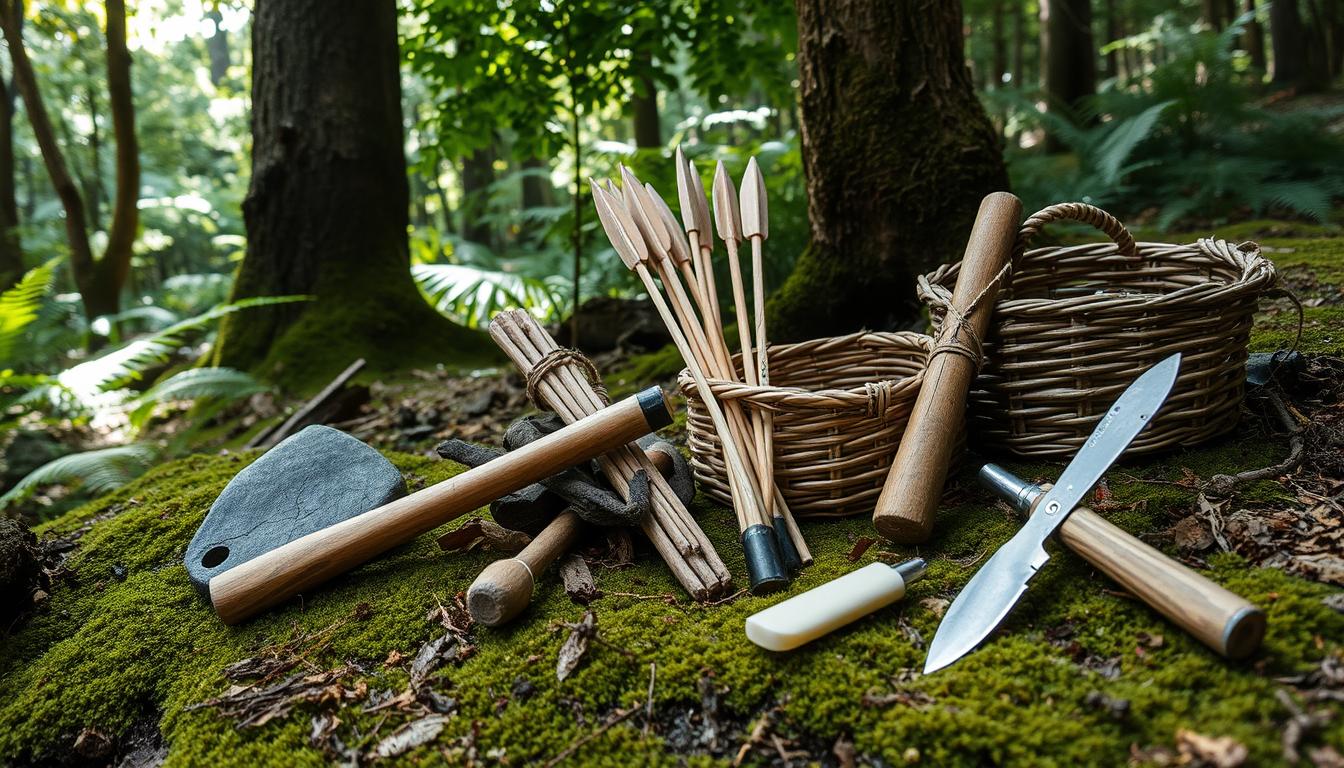Survival in the wilderness hinges on the ability to create and use tools crafted from nature’s bounty. This is not just a testament to self-sufficiency but a return to the roots of human ingenuity. From building prawn traps to fashioning spears and constructing grass huts, the ancient art of survival crafting is both cost-effective and empowering.
Gathering materials from nature and turning them into essential implements for wilderness survival nurtures a deep appreciation for the environment. The process demands core skills such as knot tying, woodworking, and fire starting. Each of these skills plays a critical role in transforming simple materials into functional DIY survival tools that can make the difference between life and death in a survival scenario.
Understanding how our ancestors thrived using nature’s tools imparts valuable knowledge and technique that modern technology often overshadows. Whether it’s selecting the right wood, utilizing stone, bone, or other materials, or mastering the meticulous construction of survival tools, these practices are invaluable in wilderness survival contexts.
Key Takeaways
- The creation of primitive tools requires understanding suitable materials such as specific rocks, shells, and bones.
- Bamboo, cane, or saplings make effective darts for atlatls, with specific diameter recommendations.
- The atlatl’s crafting involves dimensions relative to your body measurements and allows for flexibility in survival crafting techniques.
- Stone tools play a crucial role in the construction and finishing of tools like the atlatl and dart.
- Fire-starting techniques using wood friction are fundamental skills in primitive survival scenarios.
- Survival crafting demands careful selection and utilization of natural resources, along with skill refinement and practice.
In subsequent sections, we will delve into the specific skills and techniques required to craft and use these life-saving tools, ensuring that you’re well-equipped for any wilderness survival situation.
Introduction to Primitive Survival Tools
Embarking on the journey of primitive living reconnects you with ancient techniques and the ways our ancestors survived using nature’s provisions. By delving into tool making, you’ll discover the life-saving tools crafted from stone, wood, bone, and plant materials.
Fieldcraft courses offered by Another Summit emphasize the significance of tools in the wilderness. Through hands-on workshops, you’ll learn the essential acronym SWFFT: Shelter, Water, Fire, Food, and Tools. These courses facilitate the mastery of constructing and utilizing these life-saving tools, incorporating knowledge gained from bushcraft veterans.
Environmental ethics play a crucial role by promoting responsible outdoor behavior and minimizing our impact on nature. You’ll gain skills such as identifying edible plants like dandelion greens and cattail roots, recognizing medicinal plants like yarrow and plantain, and crafting natural cordage from nettles and yucca.
“Knowledge of natural resources and sustainable practices is fundamental in bushcraft, ensuring not only survival but the preservation of the environment for future generations.”
In tool making, learning to fashion fire boards and spindle sticks is part of fieldcraft courses, while knowing which wood types are best for burning enhances your efficiency in outdoor environments. Furthermore, blending into your surroundings using stealth and camouflage is vital to avoid detection by wildlife and potential threats.
Crucial bushcraft skills encompass water sourcing and purification methods, shelter-building, and navigation. These skills enhance your survival capabilities, increasing self-reliance, confidence, and emotional resilience. Utilizing primitive methods like traditional bowhunting for sustenance underscores the practical applications of ancient techniques.
Maintaining and sharpening tools is just as important as the initial crafting process. Essential tools such as knives, fire starters, containers, and tarps are indispensable for survival. For instance, the official bow drill kit, priced at $45.00, and the versatile cloth used for various survival purposes, costing $25.00, are pivotal items that highlight the role of tools in primitive living.
| Item | Description | Price |
|---|---|---|
| Official Bow Drill Kit | Complete set for fire making using ancient techniques | $45.00 |
| PWS “Primal” Blade | Handcrafted knife by Phillip | $100.00 |
| Versatile Cloth | Useful in various survival scenarios | $25.00 |
| Woods Trekker Course | Comprehensive course for self-reliance | $200.00 |
| Antler Handled Ferro Rod | Effective for fire making | $15.00 |
Essential Skills for Crafting Primitive Tools
The ability to craft survival tools is rooted in a suite of skills that are both varied and vital. Mastering these skills can significantly increase your self-sufficiency and resourcefulness in the wilderness. Essential skills such as woodworking, knot tying, fire starting, and tool improvisation are fundamental in creating effective DIY survival tools from nature.
Woodworking Techniques
Basic woodworking techniques are critical for making survival tools by hand. This skill not only involves understanding the materials but also tapping into your creativity to shape tools like spears, bows, and arrows from wood found in nature. Effective woodworking leads to increased self-sufficiency and can be a cost-effective alternative to buying gear.
Knot Tying Skills
Knot tying is an indispensable skill for survival. It’s crucial for securing materials, building structures, and creating traps. Whether it’s making snares for hunting or tying components together for a shelter, mastering various knots can enhance your survival skill set exponentially, providing a vital edge in emergency situations.
Fire Starting Methods
Fire starting is a critical skill that can provide warmth, light, and cooking capabilities in the wilderness. Traditional methods like bow drills, flint and steel, and even solar techniques showcase human resourcefulness and are valuable survival skills. Successfully mastering fire starting methods is imperative for any survival scenario.
Tool Improvisation
Tool improvisation encourages you to think outside the box, utilizing available resources creatively and effectively. This skill is essential for adapting to specific needs and environments, increasing your chances of survival. From crafting prawn traps to makeshift cord drills, improvisation allows you to personalize your tools for maximum effectiveness.
To summarize, honing these essential skills of woodworking, knot tying, fire starting, and tool improvisation significantly boosts your ability to thrive in the wilderness with DIY survival tools. Not only are these skills economically beneficial, but they also provide a profound sense of self-confidence and fulfillment.
Primitive Materials: What Nature Offers
When facing survival situations, recognizing and utilizing the wealth of natural materials at your disposal can be a game changer. These resources, such as the right wood, sharp stone tools, and efficient cordage, can transform your ability to create life-saving gear.
Choosing the Right Wood
Choosing the right type of wood is essential for crafting durable and effective primitive tools. Hardwoods such as oak, hickory, and ash are favored for their strength and versatility. For tool handles, bows, and fire drills, the resilience of hardwood makes it a preferred choice. On the other hand, softer woods like pine and cedar are useful for carving and creating shelters due to their ease of workability. Mastery in woodworking techniques can significantly enhance your survival prospects.
Utilizing Stone and Bone
Since ancient times, humans have relied on sharp stone tools for survival. Stones like flint, obsidian, and chert are excellent materials for crafting various tools and weapons. Obsidian, found in states like Arizona, Colorado, and Oregon, is renowned for its sharp edges, while chert, often varying in color, is a reliable material for knapping. Bones, too, are invaluable; fashioned into tools such as bone awls and needles, they expand your capability to work with other materials and create functional items.
Finding Natural Fiber for Cordage
Cordage is indispensable in the wilderness, aiding in tasks from building shelters to crafting fishing nets. The fibers from plants such as yucca, inner tree bark, and nettles can be transformed into sturdy ropes and twines. The knowledge of plant families and their uses is crucial in identifying the best sources of natural materials for cordage. Consistently producing robust cordage showcases proficiency in primitive survival skills.
Understanding how to identify and leverage these materials not only enhances self-reliance but also connects you to some of the oldest survival techniques known to humanity. Whether crafting from natural materials or expertly crafting sharp stone tools, your journey in mastering these primitive skills ensures preparedness for any wilderness challenge.
Crafting Essential Primitive Tools for Survival
Mastering the art of crafting essential primitive tools can be a game-changer in any survival situation. With a bit of resourcefulness and the right skills, you can transform ordinary natural materials into life-saving implements. Let’s delve into three fundamental tools that every survivalist should know how to craft: a survival spear, a DIY survival bow, and a prawn trap.

Building a Survival Spear
The survival spear is one of the simplest yet most effective tools to craft from nature. By selecting a sturdy branch, you can easily fashion a weapon capable of hunting large game or defending against predators. The key is to ensure the branch is not too brittle and to sharpen one end to a fine point, which can be hardened through slight charring over a fire. Moreover, securing a stone or metal tip, if available, will significantly improve its efficiency.
Making a DIY Survival Bow and Arrows
A DIY survival bow serves as a crucial tool for hunting and protection. Crafting one requires selecting a flexible yet strong wood for the bow, such as oak or hickory. The process is time-consuming but rewarding, involving precise carving and bending. The arrows, crafted from straight hardwood shafts, must be paired with sharpened stone or metal tips and natural fletching to ensure accuracy and lethality.
Creating a Prawn Trap
Primitive trapping for aquatic creatures, like prawns, can be achieved with ingenuity and patience. A prawn trap can be easily constructed using natural materials such as lawyer cane and vine. By weaving these materials into a conical shape with a small entrance, you can create an effective mechanism for catching prawns. Place the trap in shallow waters and await the bounty. This method not only provides sustenance but also embodies the resourcefulness crucial for survival.
Learning these skills enhances your capacity to thrive in the wilderness, turning simple materials into versatile survival tools.
| Tool | Materials | Usage |
|---|---|---|
| Survival Spear | Sturdy Branch, Stone or Metal Tip (optional) | Hunting, Protection |
| DIY Survival Bow | Flexible Wood, Hardwood Shafts, Stone or Metal Tips | Hunting |
| Prawn Trap | Lawyer Cane, Vine | Trapping Aquatic Creatures |
Mastering these crafting skills not only equips you with essential survival tools but also fosters a deeper connection with nature. Whether you’re wielding a survival spear, aiming a DIY survival bow, or setting a primitive trapping system, each crafted element embodies resilience and ingenuity.
Primitive Shelter Making: Grass Huts and Caves
Shelter is a principal need in survival scenarios, and mastering the art of constructing *wilderness survival shelters* with limited resources is a crucial skill. Two primary methods are commonly used by survivalists: building *grass huts* and utilizing *natural caves*. Both options offer much-needed refuge and can be the difference between endurance and defeat.
Building a Grass Hut
Building a grass hut demands an understanding of your environment and the materials available. Grass huts are constructed using layers of grass, leaves, and branches to create a waterproof and wind-resistant structure. An essential first step is gathering ample branches to form the framework. These must be sturdy enough to support the weight of the grass and leaves used for insulation.
Once the frame is assembled, natural cordage can be used to bind the components together securely. Overlapping grass and leaves are then layered on the framework to ensure maximum protection from the elements. Remember, the key to an effective grass hut is in the dense layering of insulation materials to minimize exposure to rain and wind.
Utilizing Natural Caves
When seeking immediate shelter, natural caves often present an excellent option. These ready-made *naturally occurring shelters* can be found in various terrains and offer immediate protection from weather and predators. To enhance the security and comfort of a natural cave, consider blocking the entrance with branches or stones, leaving enough space for ventilation. This will help to maintain warmth and keep out unwanted intruders.
Properly utilized, natural caves can serve as a temporary or longer-term solution, especially when conditions make building other types of shelters impractical. However, it’s important to inspect any natural cave for potential hazards like loose rocks or wildlife before settling in.
| Type of Shelter | Materials Needed | Features |
|---|---|---|
| Grass Hut | Branches, Grass, Leaves, Natural Cordage | Waterproof, Wind-resistant, Dense Insulation |
| Natural Cave | Existing Cave Structure, Rocks, Branches for Enhancements | Immediate Shelter, Protection from Elements and Predators |
In conclusion, the ability to create effective *wilderness survival shelters*—whether through crafting *grass huts* or optimizing *natural caves*—is a vital skill for any survivalist. By understanding these methods, you can ensure your safety and comfort in the wild, aiding your long-term survival in unpredictable environments.
Primitive Food Gathering and Hunting Tools
Mastering the art of primitive food gathering is essential for survival. Nature offers a bounty of resources, but knowing how to effectively secure your food can make all the difference. Crafting tools such as fishing nets and traps, as well as hunting traps and snares, can ensure a steady supply of nourishment with minimal expenditure of energy.

Making Fishing Nets and Traps
Fishing nets and traps are invaluable for primitive food gathering. Crafting these tools requires understanding the best materials to use and the techniques for making them effective. By utilizing natural fibers for cordage and ensuring proper net weaving techniques, you can create nets that capture a variety of fish. Additionally, designing traps to place strategically in streams or along shorelines can guarantee a rewarding catch.
- Collect natural fiber from plants such as dogbane, milkweed, or stinging nettle.
- Weave the fibers into a robust net using knot-tying skills.
- Position the fishing traps in active fishing spots for sustained food supply.
Crafting Hunting Traps and Snares
Creating effective hunting traps and primitive hunting snares can significantly contribute to your survival efforts. These devices, when expertly crafted and strategically placed, can capture essential game without the need for exhaustive physical exertion.
- Choose the appropriate materials such as pliable wood and sturdy cordage.
- Design traps like the simple deadfall or spring snare to capture small game.
- Place your hunting traps and snares in areas with high animal traffic, ensuring the highest possible success rate.
With these tools and techniques, you will be well-equipped to handle the challenges of primitive food gathering. Your creativity and resourcefulness in making and deploying fishing nets, hunting traps, and primitive hunting snares will be the cornerstone of your sustenance strategy.
Primitive Tools for Survival: Real-World Applications
The practical application of primitive tools in survival situations reveals a profound connection between ancient craftsmanship and modern necessity. Knowledge in real-world survival applications can be a valuable lifesaver. Crafting tools using natural resources is not only a testament to human ingenuity but also an essential survival skill.
Making a Cord Drill
A cord drill is a quintessential example of leveraging basic mechanics to meet critical needs like fire starting. Constructing a cord drill involves creating a simple yet effective apparatus from natural materials. By assembling a shaft, flywheel, and cord, you can generate the necessary friction to ignite tinder, providing you with the warmth and ability to cook food.
Mastering the cord drill not only showcases your resourcefulness but also adds a powerful tool to your survival arsenal. This technique underlines the cost-effectiveness and practicality of acquiring essential survival skills over purchasing expensive gear.
Fashioning Bone Tools
Bone tool making is another vital skill in real-world survival applications. Using bones, you can create durable and versatile tools, ranging from needles for repairing clothes to fish hooks for securing food. The art of bone tool making highlights the depth of ancient craftsmanship and its relevance today.
In essence, fashioning bone tools demonstrates human resilience and the extraordinary utility of seemingly mundane materials. This skill, combined with the ability to make a cord drill, elevates your survival capabilities and allows for significant bartering possibilities due to the scarcity of individuals skilled in crafting such tools.
Understanding and practicing these real-world survival applications not only equips you for emergencies but also connects you to a long lineage of human innovation and adaptability.
Conclusion
In traversing the ancient methodologies of survival, the mastery of primitive tools stands as a testament to human ingenuity and adaptability. By grasping the vital skills and techniques outlined in this article, you empower yourself to achieve self-sufficiency even in the most challenging environments. Crafting tools, building shelters, sourcing water, and hunting for food are not just survival strategies; they are pathways to a deeper connection with nature and a profound sense of self-reliance.
The ability to improvise in a survival situation is crucial. From the art of constructing a survival spear to the precision required in making a DIY bow and arrows, each technique enhances your preparedness for emergency situations. Emphasizing the importance of mental clarity and practical skills, these age-old practices ensure that you are not merely surviving but thriving when faced with adversity.
Embodying these methods brings you closer to the essence of survival. The knowledge that a human can survive just three to five days without water underscores the urgency of mastering water purification techniques. Similarly, crafting effective shelters and gathering food using traditional tools reveals the timeless value of these skills. Whether it’s utilizing the bow drill method for fire-making or weaving fishing nets, each ability not only offers a practical solution but also reconnects us with the self-reliance our ancestors embodied.
Embracing these survival skills allows you to transform nature’s offerings into life-saving resources, highlighting the importance of both physical and mental preparedness. Ultimately, by equipping yourself with these ancient techniques, you gain the invaluable ability to face the wild with confidence and adaptability, ensuring your survival in any situation.
FAQ
What are primitive tools for survival?
Primitive tools for survival are handmade tools crafted from materials found in nature, designed to assist in wilderness survival. They can include sharp stone tools, cordage, fire starters, and other life-saving tools like spears and fishing nets.
Why is it important to learn how to make primitive tools?
Learning to make primitive tools fosters self-sufficiency and resourcefulness. It helps you adapt to survival situations by utilizing nature’s materials, ensuring you can craft the necessary tools for shelter, food gathering, and protection.
What materials are commonly used to make primitive tools?
Common materials include wood, stone, bone, and natural fibers. These materials are often readily available in natural environments and have been historically used to craft essential survival tools.
How do I select the right wood for tool making?
When selecting wood, consider its strength, flexibility, and grain. Hardwoods like oak and hickory are durable and ideal for tools requiring toughness, while softer woods like willow are better for weaving and cordage.
What are some essential woodworking techniques for primitive tool crafting?
Essential techniques include carving, notching, and splitting wood. These skills help in shaping wood into useful tools and structures, like spears, shelters, and simple machines.
How can knot tying skills aid in survival situations?
Knot tying is crucial for securing shelters, creating fishing nets, and making traps. Knowing a variety of knots enhances your ability to construct, bind, and secure essential survival equipment efficiently.
What traditional methods are effective for starting a fire?
Traditional fire starting methods include using a bow drill or a cord drill. These techniques involve friction and require patience and practice but are reliable sources of ignition in a wilderness survival situation.
How can stone tools be utilized in primitive survival?
Sharp stone tools can be used for cutting, scraping, and hunting. They are essential for creating other tools, preparing food, and crafting everyday survival necessities.
What are the steps to build a survival spear?
To build a survival spear, find a sturdy, straight branch and carve one end to a sharp point. Temper the point by carefully hardening it in fire to increase its durability and efficiency as a hunting tool.
How can I make a DIY survival bow and arrows?
Crafting a survival bow requires selecting a flexible yet strong branch, typically from a hardwood. Carve and shape the bow, then attach a strong cordage string. Arrows are made from straighter, lighter wood, with pointed tips and feathered ends for stability.
How do natural materials like fiber aid in making cordage?
Natural fibers from plants like hemp, jute, and yucca can be twisted and braided into strong, durable cordage. This cordage is indispensable for tying, binding, and constructing essential survival items.
What are some practical uses of bone tools in survival crafting?
Bone tools can be shaped into needles, fish hooks, and cutting implements. They showcase the versatility of natural materials and can be crucial for constructing other survival tools and garments.
How can grass huts and natural caves be utilized for shelter?
Grass huts, made from branches, leaves, and natural cordage, provide insulation and protection from the elements. Natural caves offer secure shelter, which can be improved with added insulation and protection to serve as a long-term refuge.
What are effective methods for building fishing nets and traps for food gathering?
To build fishing nets and traps, use natural fibers or cordage to create mesh patterns and frames. Placement is key—locate areas where fish are abundant, using natural currents and bottlenecks to your advantage.
Source Links
- https://www.instructables.com/Make-a-Survival-Atlatl-and-Dart-With-Only-Found-Ma/
- https://www.outdoorlife.com/story/survival/primitive-survival-skills-that-will-keep-you-alive/
- https://thesurvivaluniversity.com/survival-tips/why-a-knife-is-not-your-most-important-survival-tool-skills-vs-tools-in-real-life-scenarios
- https://www.guardianrevival.org/blog/survival-skills-in-the-wild-an-introduction-to-fieldcraft
- https://www.outdoorlife.com/survival/bushcraft/
- https://www.primitivewildernesssurvival.com/shop
- https://natureofthenorth.co/basics/diy-survival-tool-crafting/
- https://rethinkrural.raydientplaces.com/blog/primitive-crafts-survival-skills-for-uncertain-times
- https://masterwoodsman.com/arts-sciences/primitive-skills/
- https://www.primitiveways.com/
- https://www.geekslop.com/life/survival/tools-supplies/2015/how-to-build-primitive-weapons-and-tools-from-natural-bone-rocks-shells-antlers-or-animal-teeth
- https://www.homesteaddreamer.com/2016/07/13/7-primitive-tools/
- https://katiegrovestudios.com/crafting-the-ancient-toolkit-primitive-skills-series/
- https://yostsurvivalskills.com/wilderness-survival-skills/
- https://ridgerunnersurvival.tripod.com/shelter.htm
- https://valleyfoodstorage.com/blogs/inside-vfs/survival-shelter-long-term-primitive?srsltid=AfmBOormws4FlpISQHzJxLh9xYrc2X_CupJH42qdBbZjHzdlvFhk8Dev
- https://humanorigins.si.edu/human-characteristics/tools-food
- https://blog.woodland-ways.co.uk/primitive-crafts/the-hunter-gatherer-equipment-list/
- https://survivalskills.guide/long-term-wilderness-survival-gear/
- https://www.exploretruenorth.com/survival-primitive-v-practical/
- https://en.wikipedia.org/wiki/Survival_skills
- https://medium.com/survival-family/10-vital-primitive-survival-skills-that-all-families-learn-e5d787a2a652
- https://silverantoutdoors.com/blogs/the-silverant-blog/back-to-basics-a-guide-to-primitive-bushcraft-techniques

